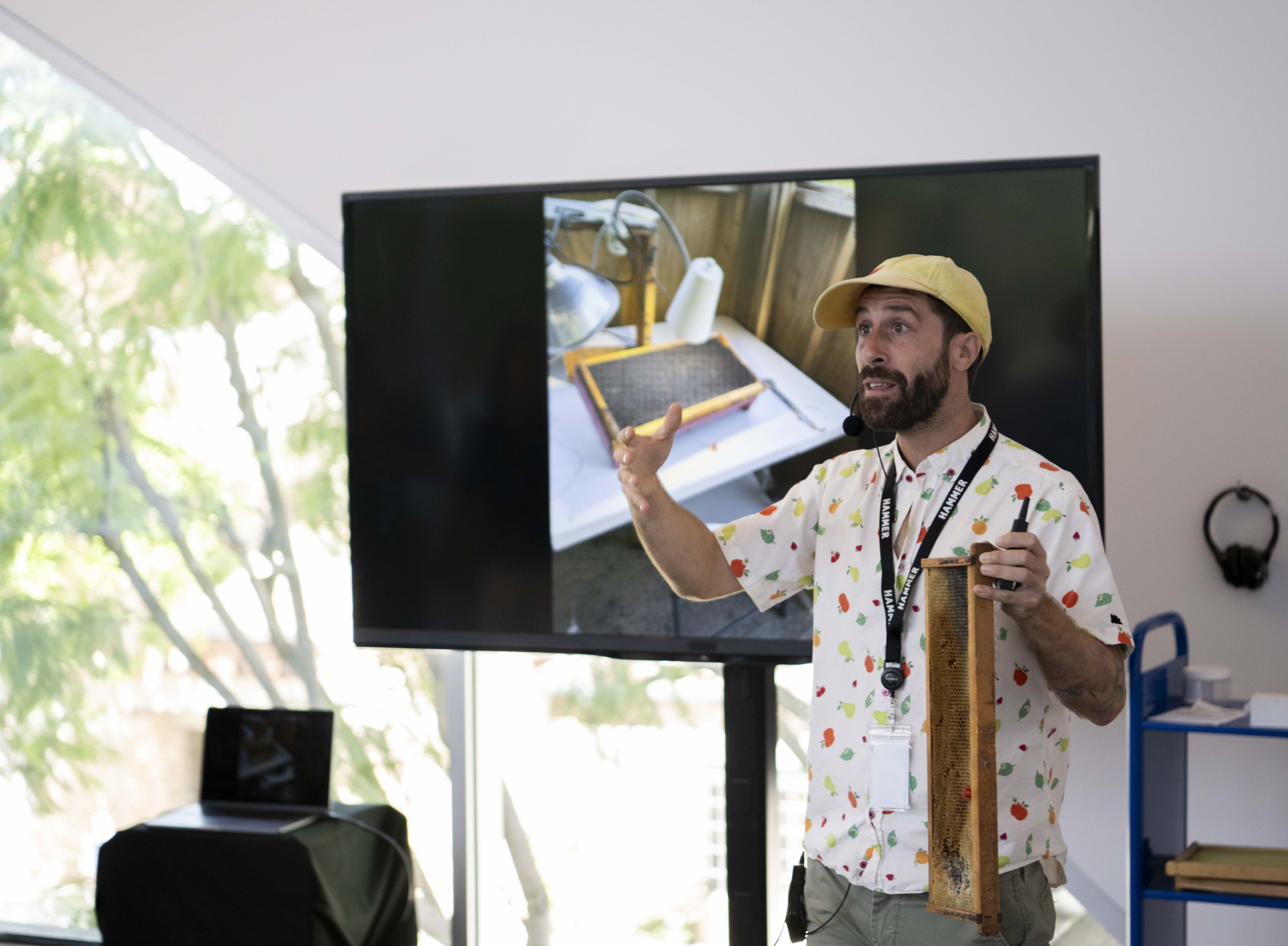From screenings to beekeeping talks, Hammer Museum buzzes with Bee Week events
The Hammer Museum was abuzz with Bee Week festivities.
During Bee Week, which lasted from Oct. 13 to Sunday, the Hammer Museum hosted honey tastings, bee talks and screened the award-winning nature documentary, “Microcosmos.” As part of this programming, the Hammer Museum hosted beekeeper Joe O’Brien from Tuesday to Sunday to talk about queen bee breeding and biodiversity. O’Brien’s presentation, which was given multiple times a day throughout the six-day span, lasted just over an hour and was accompanied by the work of beekeeper and sculptor Garnett Puett. Puett creates “apisculptures” – a term derived from apis, the Latin word for bee – using strategically placed queen bees that construct their hives around a beeswax sculpture. To make these sculptures, Puett needs queen bees, and that’s where O’Brien said his specialty in breeding comes in.
“When I find the queen, I pick her up, and when I’m looking inside that box, I’m assuming if she’s doing her job or not,” O’Brien said. “I like to think I’m putting her through a little bit of a bee bar. If she wants to be my little bee lawyer, she has to do her test and pass it.”
This test, O’Brien said, is producing eggs that can be fertilized to become new queen bees. He added that once a queen lays an egg, that egg can be transported into a new cell: one that is structured to support queen growth. During his presentation, O’Brien passed around a model of a queen cell and a comb of worker bee cells, demonstrating the difference between the structures. He also drew attention to the difference in capabilities of bees. Male bees don’t produce honey and exist for the purpose of mating, O’Brien said.
“What do the boys do? Fly? Good answer – nothing,” he said. “The boys have big eyes, full of excuses, big fluffy butts. … They are basically big, bumbling mating drums.”

The variation in bees extends beyond sex differences and capability. O’Brien added that there are 20,000 species of bees globally, with over 4,000 of those in the United States and 1,600 in California. However, only about 4% of species produce honey, he said. The scarcity of honey-producing species stood out to an attendee of the talk, Tony Mattcitwson, a Brentwood resident who said he gained insight into the percentage of species capable of creating honey and appreciated the educational nature of O’Brien’s talk.
After expanding on the species diversity of bees, O’Brien discussed plant diversity, adding that native flora is important in promoting healthier ecosystems. Not only do native plants aid biodiversity, but they also reduce water consumption and require less care, he said. O’Brien added that novice beekeeping can harm biodiversity, negating native plant species rescue programs. Hives that people purchase to begin beekeeping may include European bees, O’Brien said, which, rather than aiding in species diversity, may harm the indigenous flora and fauna.
In lieu of amateur beekeeping, O’Brien encouraged individuals to engage in indigenous planting – a practice that resonated with Kellie Zakolski, a member of the Culver City Garden Club. Zakolski said a focus of the garden club is promoting local gardeners and businesses, which goes hand in hand with supporting native planting and pollination. Gardening also aligns with O’Brien’s advice for engaging in local ecosystems.
“You can do an online course with some fool. Who knows?” O’Brien said. “I recommend learning and directly involving yourself in your ecosystem if you want to make a difference in your backyard.”
For beekeepers, O’Brien offered insight on what considerations can be taken to support the bees other than simply planting indigenous plants. He added that natural beekeeping – a subdivision of beekeeping in which the bees are largely left alone and only periodically checked on – shortens the lifespan of the bees. Instead of approaching beekeeping with a hands-off mindset, O’Brien said he views it as something akin to parenting, where the ideal method is to help as best as one can while also encouraging independence.
“The highest degree my compassion comes from is through understanding the bees so that I can understand what I need to do,” O’Brien said. “If you want to keep your dogs and cats healthy, do you ignore them and let them run free in the wild? Or do you give them medication so they live longer and they’re healthier?”

